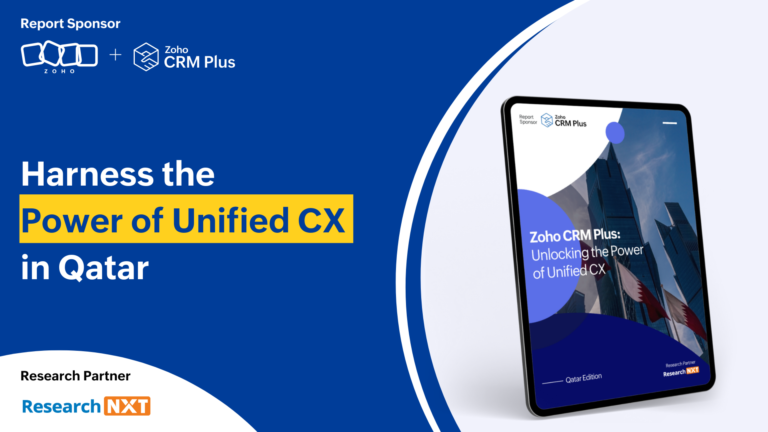
Innovating Retail IT: How LTC International Delivers Exceptional Customer Experiences
In this interview with Research NXT, Harshil Shah, Assistant Manager – IT at LTC International Qatar LLC, shares his professional journey and the pivotal role of IT in transforming customer experiences across the retail chain’s multiple brands. From implementing technologies like ERP, CRM, and e-receipts to overcoming challenges like privacy concerns and multi-location consistency, Harshil highlights how IT-driven strategies enhance operational efficiency, customer satisfaction, and business growth.
Key Takeaways:
- Harshil spearheaded initiatives like e-receipts, ERP upgrades, and CRM integration to streamline operations and enhance customer experiences.
- By leveraging ERP and CRM systems, LTC ensures seamless integration of in-store and online experiences, maintaining consistency in service quality across multiple retail locations and brands.
- Addressing privacy concerns, LTC adapted by using alternative communication methods like local media campaigns respecting cultural norms while building brand awareness.
- Customer data collected during transactions informs targeted marketing strategies, with social media emerging as the most effective engagement channel.
- LTC regularly evaluates the impact of IT-driven CX initiatives through metrics like customer engagement and feedback.
“Our ERP integrates inventory, orders, and customer data, ensuring real-time product availability, accurate pricing, and updated promotions across in-store and online channels.”
Can you share your professional journey leading to your current role as Assistant Manager – IT at LTC International Qatar LLC?
Harshil: I joined LTC International Qatar in April 2015, right after completing my Bachelor of Engineering in Computer Science from Gujarat Technological University in August 2014. After my graduation, I was on a job hunt and received an offer from Qatar. I started as an IT Assistant, where my responsibilities were managing hardware issues, handling EDP jobs, and working with GRN tasks, as we are in the retail Industry. I worked in this role for about 2 to 2.5 years.
In the year 2017, I was promoted to an Application Analyst, where I became solely responsible for managing our ERP system Microsoft Dynamics Navision. My journey continued, and in 2022, I was promoted to Application Engineer. Last year, in 2024, I was further promoted to Assistant Business Application Manager – IT, where I continue to grow and contribute to the company.
What are your core responsibilities in managing IT operations, and how do they support the company’s customer experience (CX) goals?
Harshil: As the Assistant Manager, my core responsibilities involve a wide range of tasks that support the smooth operation of the company. From supervising IT Infrastructure, EDP, Purchase, Inventory, GRN, and logistics in the absence of my Head of the Department to handling Servers, ERP and managing IT projects, I’m involved in multiple aspects of the business.
One of the recent projects I have completed was the implementation of the E-receipt functionality across all 18 stores in 2024-2025. This project has been particularly beneficial as it aligns with the company’s customer experience goals in several ways. Initially, the E-receipt reduces paper wastage, which not only supports environmental sustainability but also enhances the customer experience. Customers no longer need to worry about losing their receipts or having them fade over time.
Additionally, through the E-receipt, we can seamlessly showcase our latest collections directly to the customer, adding a personalised touch that elevates their shopping experience. In short, my role and these IT initiatives contribute directly to improving operational efficiency and enhancing customer satisfaction.
Read More
How do you define a unified customer experience (CX) within the retail industry, and why is it essential for brands like LTC International?
Harshil: A unified customer experience (CX) within the retail industry means delivering a consistent, seamless experience, whether it’s in-store, online, or through any marketplace channels. This approach ensures that customers feel valued and have a smooth, personalised experience no matter how they interact with the brand.
For our organisation, which operates multiple brands like Homes r Us, Daiso Japan, and Carter’s, providing an integrated CX is essential. Even though each brand offers a different audience and offers distinct products, it’s crucial that customers receive the same level of service, attention to detail, and ease of interaction across all brands.
For example, whether a customer is shopping for furniture at Homes r Us, picking up affordable items at Daiso Japan, or buying children’s wear at Carter’s, they should experience the same high standard of service, reliability, and convenience. This consistency in customer experience not only strengthens customer loyalty but also helps in building trust with the organisation.
How does the IT department contribute to ensuring consistency in customer interactions across online and physical retail channels?
Harshil: IT department plays a critical role in ensuring consistency in customer interactions across all channels. At LTC International Qatar, we leverage technology to bridge the gap between our online platforms and physical stores, ensuring that customers have a seamless experience no matter where they engage with us.
For example, our ERP is designed to integrate various functions like inventory management, order processing, and customer data tracking across all brands. This allows us to provide real-time information on product availability, accurate pricing, and up-to-date promotions, whether a customer is shopping in-store or online.
Additionally, we have the E-receipt, which further supports consistency by giving customers a digital version of their purchase receipt, regardless of how or where they make the purchase. This helps to maintain continuity in their shopping journey.
On the other hand, we have CRM that collects and analyses customer data from all platforms. This allows us to understand customer preferences, personalise marketing efforts, and offer tailored experiences, all while keeping the overall brand message consistent across platforms.
By providing these technological solutions, our IT team ensures that our customers always experience the same high-quality service each and every time when they walk towards us.
What technologies, such as POS systems, CRM platforms, or data analytics tools, are you using to streamline customer experiences? Can you share how it has impacted customer satisfaction?
Harshil: To streamline our customer experiences, we have adopted a range of advanced technologies. For POS, we use both FEC and NCR POS machines integrated with LS Retail as our end-to-end business solution. This setup allows us to efficiently handle sales, inventory management, and customer transactions.
Additionally, our ERP Microsoft Dynamics Navision ensures smooth backend operations from inventory to financial management. We are also moving to Microsoft’s cloud ERP Dynamics 365, which will provide even greater flexibility and scalability.
For marketing and customer engagement, we use XENO, which allows us to manage our campaigns across multiple platforms like Meta, YouTube, SMS, and email. We use local media channels, including radio and outdoor LED screens, where we promote our new collections and build brand awareness. Also, we have developed a mobile app for both Android and iOS, which enables customers to easily browse and shop from anywhere, improving accessibility and convenience.
With the growing trend of online shopping, we have also expanded into various marketplaces, making our products even more accessible to customers with just a few taps on their devices. All of these technologies work together to create a more seamless and personalised experience for our customers. By providing faster service, better product visibility, and more ways to engage, we have seen an increase in customer satisfaction, greater brand loyalty, and improved sales performance.
What are some key challenges you’ve faced in maintaining a seamless CX across multiple retail locations? How have you addressed these challenges through IT solutions or process improvements?
Harshil: One of the key challenges we’ve faced in maintaining a seamless customer experience across multiple retail locations, particularly in the Middle East, is dealing with customer privacy concerns, especially when it comes to gathering personal details like names and mobile numbers. This has been particularly challenging when interacting with female customers, as many are hesitant or offended when asked for such information, and it’s even harder to explain why we need it. To address this, we’ve adapted our approach to customer engagement. We understand that privacy is a sensitive issue, so we’re careful to communicate that the information is only used for enhancing their shopping experience and not for unsolicited marketing. However, to avoid discomfort or resistance, we’ve focused on alternative ways to communicate our brand messages without directly collecting personal data from customers.
We’ve turned to regional news channels, radio stations, and magazines for our brand communication. This allows us to reach a broader audience while respecting individual privacy preferences. By utilising these local media channels, we can promote our new collections, brand awareness, and special offers in a way that feels less intrusive and more aligned with cultural expectations. Through these strategies, we ensure that we maintain a positive customer experience while also respecting the values and preferences of our diverse customer base.
How do you use customer data and insights to personalise shopping experiences in-store and online? Can you describe a successful instance where personalisation strategies positively impacted customer retention or sales performance?
Harshil: We have implemented a system where our floor teams collect some key details from customers during transactions, such as their name, mobile number, and how they heard about us. This information is then stored alongside the transaction data. Then, we share this information with our marketing team. We analyse the data to understand which channels are most effective in reaching our customers. As a result, we discovered that social media, particularly platforms like Instagram, Snapchat, and Facebook, are much more powerful tools for engaging than other media. We shifted more of our marketing budget to focus on social media, creating reels and running targeted ads, which significantly boosted our customer reach and engagement.
What metrics or KPIs do you rely on to assess the impact of IT-driven CX initiatives in your retail operations? How do you incorporate customer feedback and technical performance data to refine CX strategies?
Harshil: We rely on key metrics like customer engagement, transaction data, and social media performance to assess the impact of IT-driven CX initiatives. During transactions, we ask customers for their names, contact details, and how they heard about us, which helps us understand which channels are most effective. Sometimes, we also ask customers to fill out feedback forms and encourage them to share their thoughts via email. Positive feedback not only boosts staff morale but also motivates them to keep delivering great experiences, helping us continuously refine our strategies. Additionally, we regularly introduce new trends and align them with technology, like offering e-bills and providing a customer support hotline.
With trends like AI-powered customer insights, self-checkout systems, and smart stores, how is LTC International preparing to adopt these innovations for better CX?
Harshil: We understand the potential of innovations like AI-powered customer insights, self-checkout systems, and smart stores. However, since we deal in value stores and furniture, adopting self-checkout for larger items isn’t feasible, as customers need to go to the cash counter for billing. Still, we are exploring the possibility of implementing self-checkout for smaller items to streamline the process and improve convenience for our customers.
What insights or best practices from your role would you like to share in this report to help other retail businesses align IT strategies with CX success?
Harshil: It is not enough to implement technology. We have to set KPIs to measure the effectiveness of our tech solutions, ensuring they align with our business objectives. These KPIs are audited at least once a year to assess how well the technology is helping us meet customer needs and how it can be improved. This evaluation allows us to make necessary changes and ensure we are always offering the best possible experience to our customers. The key is always being open to new technology that enhances the customer experience and continuously examining its impact on our business. By keeping the customer at the centre and regularly assessing our strategies, we can ensure that we are always evolving to meet their expectations.






